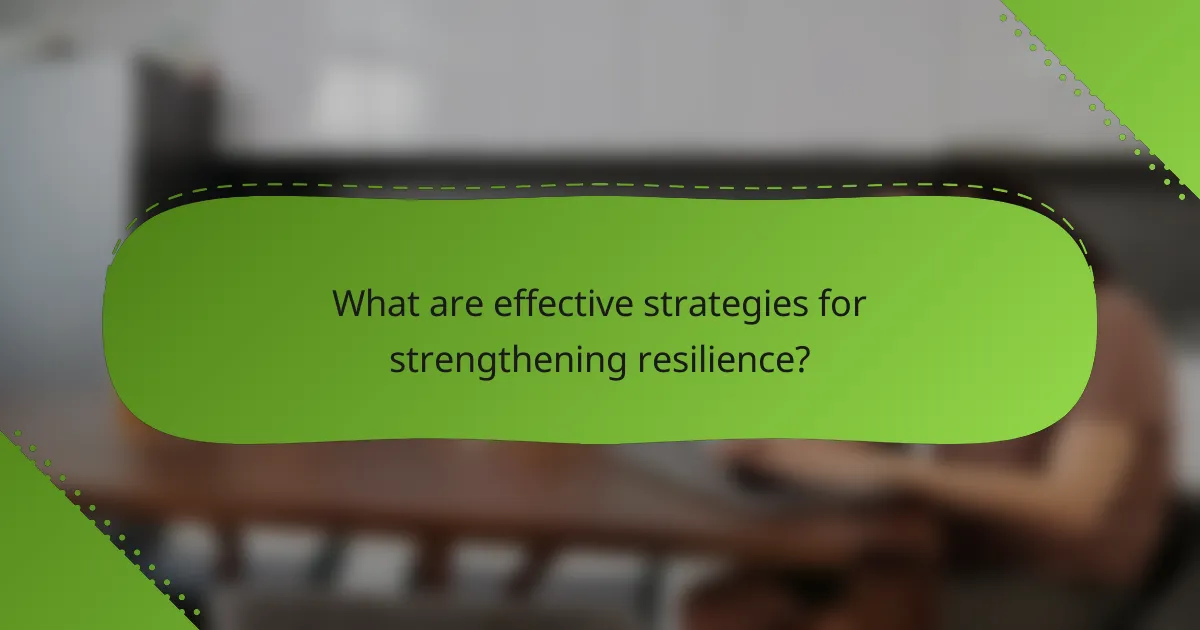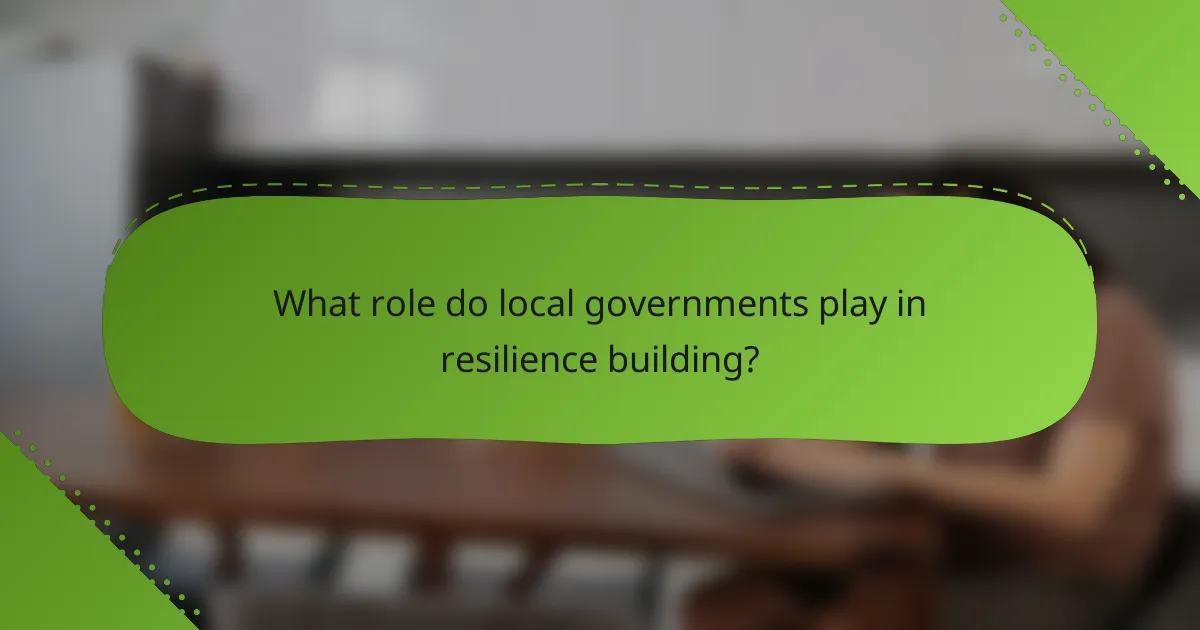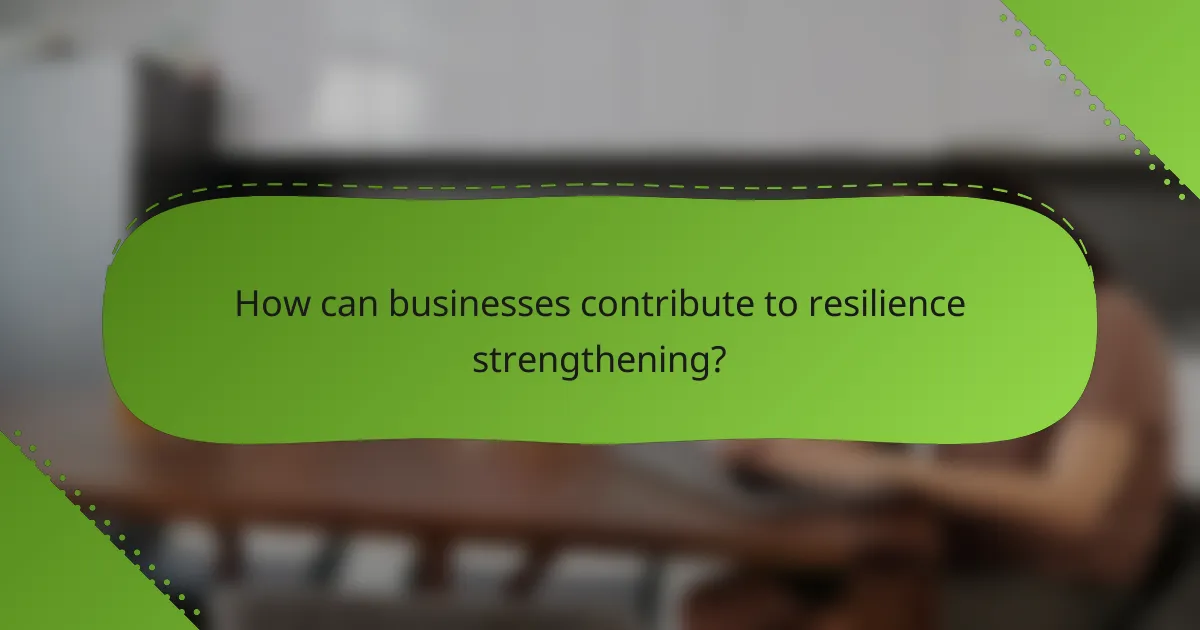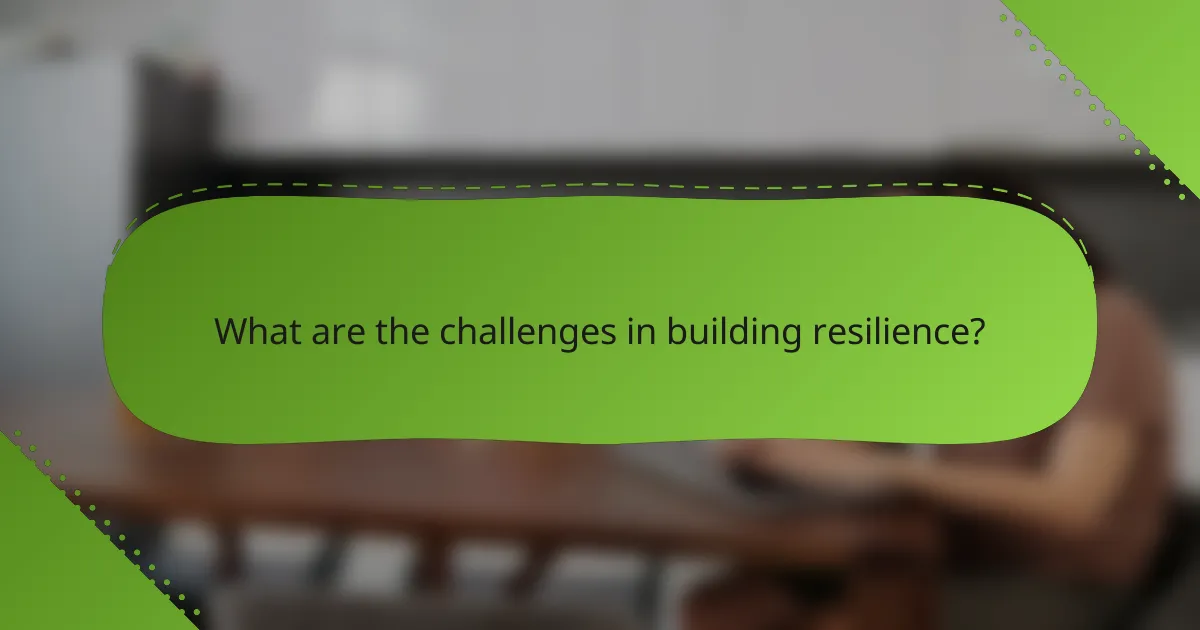Building resilience within communities is essential for effectively navigating challenges and recovering from setbacks. This involves proactive engagement, robust support systems, and collaborative efforts that strengthen social ties. By focusing on mental health, disaster preparedness, and financial accessibility, communities can enhance their capacity to cope with adversity. Local governments play a pivotal role in this process by implementing policies and engaging citizens to foster resilience at the grassroots level.

How can resilience be built in communities?
Resilience in communities can be built through a combination of proactive engagement, support systems, education, and collaboration. These elements work together to strengthen social ties and enhance the ability to respond to challenges.
Community engagement programs
Community engagement programs are essential for fostering resilience by involving residents in decision-making processes. These initiatives can include town hall meetings, workshops, and volunteer opportunities that encourage participation and ownership of local issues.
Effective programs often focus on specific community needs, such as disaster preparedness or mental health awareness. By actively involving community members, these programs help to build trust and strengthen relationships among residents.
Support networks and resources
Support networks and resources provide critical assistance during times of crisis. These can include local organizations, mental health services, and peer support groups that offer emotional and practical help to individuals and families.
Establishing a directory of available resources can empower residents to seek help when needed. Communities should promote awareness of these networks through outreach efforts, ensuring that everyone knows where to turn for support.
Education and training initiatives
Education and training initiatives equip community members with the skills necessary to navigate challenges effectively. Workshops on emergency response, financial literacy, and conflict resolution can enhance individual and collective resilience.
Programs should be tailored to the unique needs of the community, considering factors such as demographics and local challenges. Regularly updating training materials ensures that residents are prepared for evolving circumstances.
Collaboration with local organizations
Collaboration with local organizations is vital for pooling resources and expertise. Partnerships between schools, nonprofits, and government agencies can lead to more comprehensive support systems that address various community needs.
These collaborations can facilitate resource sharing, joint events, and coordinated responses to crises. Establishing clear communication channels among partners enhances the effectiveness of resilience-building efforts.

What are effective strategies for strengthening resilience?
Effective strategies for strengthening resilience include developing mental health support systems, preparing for disasters, and ensuring access to financial resources. These approaches help individuals and communities better cope with challenges and recover from setbacks.
Mindfulness and mental health support
Mindfulness practices, such as meditation and deep-breathing exercises, can significantly enhance mental health and resilience. Regular engagement in these activities helps individuals manage stress, improve emotional regulation, and foster a positive mindset.
Seeking professional mental health support is also crucial. Therapy options, including cognitive behavioral therapy (CBT) and group therapy, can provide tools and strategies to navigate life’s challenges effectively. Many communities offer low-cost or sliding-scale services to ensure accessibility.
Disaster preparedness planning
Disaster preparedness planning involves creating a comprehensive plan to respond to potential emergencies, such as natural disasters or personal crises. This includes identifying risks, establishing communication plans, and assembling emergency kits with essential supplies.
Regularly reviewing and practicing these plans can enhance readiness. Communities can organize drills and workshops to educate residents on effective response strategies, ensuring that everyone knows their role during a crisis.
Access to financial resources
Access to financial resources is vital for building resilience, as it allows individuals to recover from setbacks more effectively. This can include savings, insurance, and access to credit. Establishing an emergency fund with three to six months’ worth of living expenses is a practical step for financial security.
Additionally, communities can support financial literacy programs that teach budgeting, saving, and investment strategies. Understanding these concepts empowers individuals to make informed financial decisions, enhancing their overall resilience.

What role do local governments play in resilience building?
Local governments are crucial in resilience building as they develop policies, allocate funding, and engage communities to enhance their ability to withstand and recover from challenges. Their actions directly influence the effectiveness of resilience strategies at the community level.
Policy development and implementation
Local governments create and implement policies that address specific vulnerabilities within their communities. This includes zoning laws, building codes, and emergency response plans that are tailored to local risks, such as flooding or earthquakes.
Effective policy development involves collaboration with stakeholders, including community members and experts, to ensure that the policies are relevant and actionable. Regular reviews and updates are essential to adapt to changing conditions and emerging threats.
Funding for resilience projects
Local governments play a key role in securing and allocating funding for resilience projects. This can involve leveraging federal and state grants, as well as local budgets, to finance initiatives such as infrastructure improvements, disaster preparedness programs, and community training.
It is important for local governments to prioritize projects that offer the greatest impact on community resilience. Engaging with local businesses and non-profits can also enhance funding opportunities and foster partnerships that support long-term sustainability.
Community outreach and education
Community outreach and education are vital for building resilience, as informed citizens are better equipped to respond to emergencies. Local governments can organize workshops, distribute informational materials, and utilize social media to raise awareness about risks and preparedness strategies.
Effective outreach should be inclusive, ensuring that all community members, including vulnerable populations, have access to information and resources. Regular engagement helps build trust and encourages community participation in resilience initiatives.

How can businesses contribute to resilience strengthening?
Businesses can play a vital role in resilience strengthening by implementing strategies that enhance community and organizational stability. This includes engaging in corporate social responsibility, forming partnerships with nonprofits, and developing employee training programs focused on resilience.
Corporate social responsibility initiatives
Corporate social responsibility (CSR) initiatives allow businesses to invest in their communities while promoting resilience. These initiatives can include environmental sustainability projects, support for local education, and health programs that address community needs.
For effective CSR, companies should align their initiatives with local priorities and engage stakeholders in the planning process. This ensures that efforts are relevant and impactful, fostering stronger community ties and enhancing overall resilience.
Partnerships with nonprofits
Forming partnerships with nonprofits can amplify a business’s impact on resilience strengthening. Nonprofits often have deep community insights and established networks, making them valuable allies in addressing social issues.
Businesses should seek partnerships that align with their mission and values. Collaborating on projects such as disaster preparedness training or community health initiatives can create a more resilient society while enhancing the company’s reputation and employee engagement.
Employee training programs
Employee training programs focused on resilience can empower staff to handle challenges effectively. These programs can cover topics such as stress management, crisis response, and adaptability in the workplace.
To implement successful training, businesses should assess their specific needs and tailor programs accordingly. Offering workshops, online courses, or team-building exercises can foster a culture of resilience, ultimately benefiting both employees and the organization as a whole.

What metrics are used to measure resilience?
Resilience is measured using various metrics that assess a community’s ability to withstand and recover from challenges. Key metrics include community surveys, economic indicators, and health and wellbeing statistics, each providing insights into different aspects of resilience.
Community surveys and assessments
Community surveys are essential tools for gauging resilience, as they collect data directly from residents about their experiences and perceptions. These surveys often include questions about social cohesion, access to resources, and overall satisfaction with community support systems.
Assessments can also involve focus groups and interviews, which provide qualitative insights that complement quantitative data. Engaging diverse community members ensures a comprehensive understanding of resilience factors, highlighting areas for improvement.
Economic indicators
Economic indicators are critical for measuring resilience, as they reflect a community’s financial stability and capacity to recover from economic shocks. Common indicators include unemployment rates, median income levels, and the diversity of local industries.
Tracking these metrics over time can reveal trends that impact resilience, such as economic downturns or growth periods. Communities may also consider metrics like small business survival rates to assess their economic health and adaptability.
Health and wellbeing statistics
Health and wellbeing statistics provide insight into the physical and mental health of a community, which is vital for resilience. Metrics such as rates of chronic illness, mental health service utilization, and access to healthcare facilities are commonly analyzed.
Additionally, community wellness initiatives and their participation rates can indicate how well a community supports its members’ health. Monitoring these statistics helps identify vulnerabilities and informs strategies to enhance overall resilience.

What are the challenges in building resilience?
Building resilience faces several challenges, including limited funding and resources, as well as community resistance to change. These obstacles can hinder effective strategies aimed at enhancing resilience in various contexts, from individual to community levels.
Lack of funding and resources
A significant challenge in building resilience is the lack of adequate funding and resources. Many initiatives require financial support to implement programs that foster resilience, yet funding can be scarce, especially in low-income areas.
Organizations often struggle to secure grants or donations, which can limit their ability to develop and sustain resilience-building activities. Prioritizing funding sources and creating partnerships with local businesses or government entities can help mitigate this issue.
Community resistance to change
Community resistance to change poses another barrier to resilience building. When individuals or groups are accustomed to certain ways of life, they may be hesitant to adopt new practices or strategies that promote resilience.
To address this resistance, it is essential to engage community members in the planning process. Providing education on the benefits of resilience and involving local leaders can help foster acceptance and encourage participation in resilience-building initiatives.
